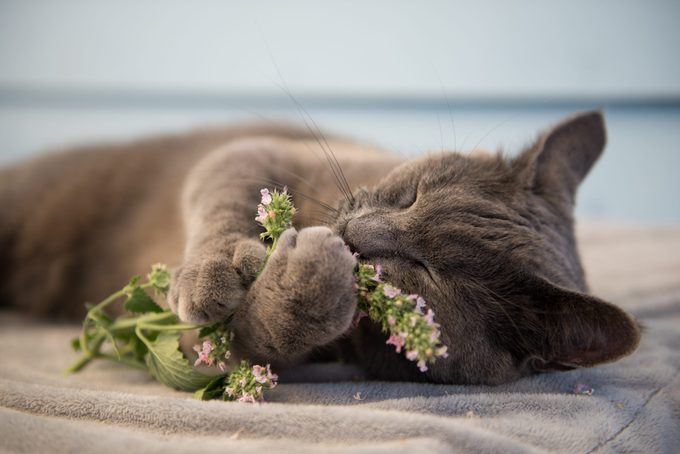Does catnip really get your kitty high? Here's what catnip does to cats—and why they are crazy about it.

What Does Catnip Do to Cats?

If you’re lucky enough to be a cat owner, you know that cat behavior runs the gamut of quirky habits, from sudden zoomies to strange noises. And if your feline friend enjoys a catnip treat now and then, you’ve probably asked yourself one (or all!) of these questions: What does catnip do to cats? How does it work? And what is catnip, anyway?
After just one sniff (or chomp) of this minty herb, many cats start acting in hilariously odd ways—rolling, darting, meowing or even zoning out. While catnip provides plenty of entertainment, it also has surprising effects that go beyond the surface.
Reader’s Digest spoke to Daniel Rotman, founder and CEO of PrettyLitter, to break down exactly how catnip affects cats, why not all cats react to it and how to use it safely for your furry friend’s enrichment. Keep reading to learn more.
Get Reader’s Digest’s Read Up newsletter for more pet insights, travel, humor, tech and fun facts all week long.
What is catnip?

Nepeta cataria, the scientific name for catnip, is an herb in the mint family that can grow up to three feet high. Native to Europe, Asia and Africa, it was introduced to North America during European settlement as early as the 18th century. Originally cultivated as a medicinal crop, catnip can now be found growing wild in every state except Hawaii and Florida.
Interestingly, catnip isn’t the only plant known to get your kitty to boogie. A study published in BMC Veterinary Research suggests that valerian root, silver vine and Tatarian honeysuckle can also have a similar effect on cats’ behavior. If your cat doesn’t respond to catnip, consider trying one of these other stimulating herbs—just make sure to use them in moderation to avoid making a dangerous mistake when introducing something new. Always watch your cat’s reaction, and consult your vet if you’re unsure.
So what does catnip do to cats?
Cats like catnip for two primary reasons: Smelling it stimulates their senses, and eating it tends to calm them down.
Felines have keen noses, and they are especially receptive to nepetalactone, a volatile oil (one that evaporates in the air) found in the stems and leaves of catnip. When they get a whiff, the active compound binds to receptors in the cat’s nose and stimulates its sensory neurons, Rotman says. Imagine your cat transforming into a kitten again—batting at invisible toys, chasing its tail and rubbing its face on the carpet with intense focus. They may display sudden bursts of energy, make strange howling noises and roll around playfully before eventually zoning out.
However, when a cat eats catnip, it has a calming effect. “If the catnip is ingested, it causes fatigue and works as a sedative,” Rotman says. “For cats that sniff catnip and rub against the plants, they’ll get more of the stimulating effects.” But not to worry: “Both smelling and ingesting catnip is safe for your feline family member.”
How long do the effects of catnip last?
Catnip’s effects are short-lived, typically lasting five to 30 minutes, according to Rotman, though not all cats will even respond. “About 50% of cats seem to be affected by catnip, and the behavior that results varies widely between individuals,” he says. “[This] is an inherited sensitivity, and it doesn’t show up immediately. Instead, it will take a few months since young kittens are not affected.”
So if your adult cat seems unfazed by catnip, it’s likely due to genetics.
What are the benefits of catnip?
Quite a few! If you have an indoor-only cat, you probably worry about them not getting enough stimulation. After all, you can’t be around to play with them every moment they’re awake. Studies show that cats, like all animals, need mental and physical exercise to be happy, and an engaging experience like sniffing or eating catnip could be part of that enrichment.
Cats that don’t receive enough stimulation may develop aggressive, depressed or anxious behavior—so it’s crucial to keep an eye out for the silent signs your cat is depressed. Catnip can be a fantastic tool for enrichment, encouraging exercise through play, or it can provide a calming effect during stressful situations like vet visits. But make sure to use ingested catnip sparingly and only if your cat responds with relaxation.
What are the drawbacks of catnip?
Catnip is generally safe. But like everything, moderation is key. Don’t give your cat too much catnip, as it can lead to dizziness or vomiting. Generally, offering it once a week in small quantities is a good guideline. Fresh catnip tends to be more potent than dried, and catnip sprays can be used on a favorite toy or scratching post if your kitty gets an upset stomach from eating the herb. Cats love eating grass, so if yours doesn’t respond well to catnip, try allowing them a few nibbles of grass and sticking to catnip sprays.
Does catnip make cats high or addicted?
Although catnip might lead to some seemingly drug-like behaviors, Rotman confirms that it’s not addictive for cats. However, he does point out that catnip can sometimes trigger aggression in some cats. “If you have a multi-cat household, it’s recommended to introduce catnip to each cat individually to avoid any potential fighting,” he advises.
Tips for introducing your cat to catnip
If your cat has never felt the euphoria of a catnip trip, follow these tips to ensure a safe ride.
- Offer a small amount and observe your cat’s reaction in a safe environment. This will help you understand their individual response and ensure they don’t have any adverse reactions.
- Avoid using catnip with cats that have a history of aggression, as it could potentially exacerbate these tendencies in some individuals. Always observe your cat’s reaction closely.
- Choose products from trusted pet stores or online retailers to ensure safety and potency. You can find high-quality catnip in various forms, including dried leaves, sprays and toys.
- Try making homemade catnip treats if your cat doesn’t know what to do with a pile of loose herbs. But keep in mind that while catnip is safe for play or stress relief, it’s not a source of nutrition.
FAQs
Is it OK to give my cat catnip every day?
While generally safe, it’s best used in moderation, such as once a week, to maintain its novelty and prevent potential digestive issues or overstimulation in some cats.
Why do some cats react so strongly to catnip?
This intense response stems from nepetalactone binding to specific receptors in their nasal passages, which in turn stimulates sensory neurons that influence their mood and behavior.
Beyond catnip, what else can I use to enrich my cat’s environment?
Excellent alternatives include silver vine, valerian root and Tatarian honeysuckle, which can have similar stimulating effects on some cats. Interactive toys, puzzle feeders, scratching posts and regular play sessions are also vital for their well-being.
Why do some cats seem completely unaffected by catnip?
The ability to react to catnip is an inherited genetic trait. Age also plays a key role—kittens younger than a few months typically lack the necessary sensitivity.
About the expert
|
Why trust us
At Reader’s Digest, we’re committed to producing high-quality content by writers with expertise and experience in their field in consultation with relevant, qualified experts. We rely on reputable primary sources, including government and professional organizations and academic institutions as well as our writers’ personal experiences where appropriate. We verify all facts and data, back them with credible sourcing and revisit them over time to ensure they remain accurate and up to date. Read more about our team, our contributors and our editorial policies.
Sources:
- Daniel Rotman, CEO of PrettyLitter
- BMC Veterinary Research: “Responsiveness of Cats”
- Behavioural Processes: “Active and Passive Responses to Catnip”
- Scientific American: “How Does Catnip Work Its Magic on Cats?”
- PetMD: “Why do some cats not react to catnip?”
- USDA: “Nepeta cataria L.”
- The Ohio State University: “Ohio Perennial and Biennial Weed Guide”























